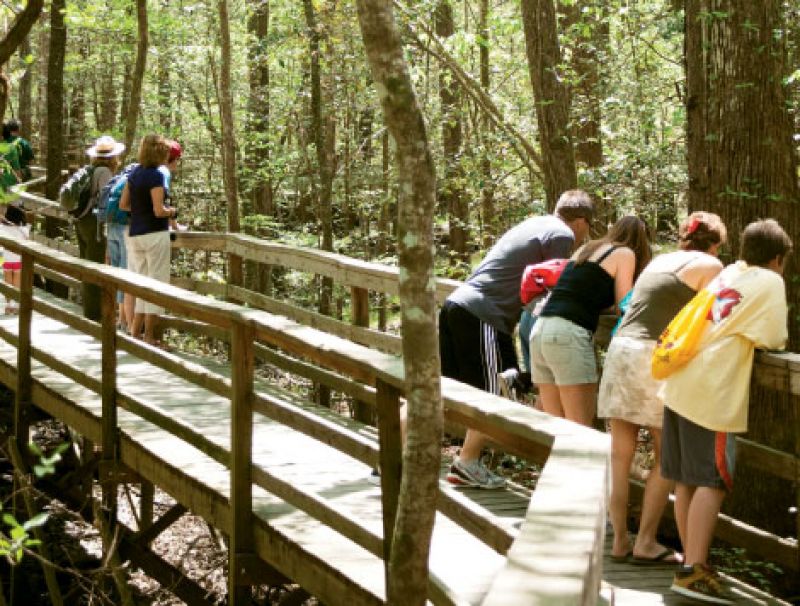
The air was jungle-like. Somewhere, a woodpecker drummed on a tree. Tiny purple flowers bloomed on the bank, and the only man-made sound was the faint whistle of a train somewhere far off. Within five minutes of unloading gear at one of the canoe landings at Congaree National Park, a black racer slipped across a sunny bank of last year’s dry leaves and then disappeared. It happened too fast to get a very good look, but I’d guess the snake was about four feet long.
The wild sounds and sights would keep coming. On the slow-flowing blackwater of Cedar Creek, we glided past wide-bottomed cypress trees, their buttressed, smooth trunks twisted into arches or wrapped around one another before rising upward 100 feet and more. The glassy water allowed for mirror images of the trunks, reflection pools in a natural sculpture garden. After paddling and floating a while, I spied a bird fly through the trees in a flash of white and red. It must have been a pileated woodpecker, one of the largest in North America.
A few minutes later, there was a sudden crashing in the woods to one side of the creek. Was that a deer? A blur of something pale, almost white, flashed past. We’d long since stopped talking, and as I sat watching and listening, I pictured it again in my mind. What I’d seen looked a bit like… a unicorn. I know it wasn’t, but in the wildness of the swamp—with all of that birdsong and chatter in the trees, and here and there a snap or a small splash—your imagination gets a little wild, too.
After the paddle and hefting the canoe back onto the station wagon, we drove a little further and stopped at the spacious Harry Hampton Visitor Center. (It’s large enough to display full-size models of massive tree trunks indoors.) Just outside the building, a park ranger had begun a group walk on the boardwalk trail and was pointing out frogs in the water below, a skink on a tree. People leaned on wooden rails to see and asked questions, though I decided not to inquire about unicorns. From the boardwalk, it’s amazing to see the enormous, champion loblolly pine trees—one soaring more than 160 feet into the air.
Besides the park itself, there are some interesting sights on the drive to Congaree. After exiting from I-26 onto Highway 601, there’s a stretch of about 36 miles of mostly rural two-lane roads. The largest town along the way is St. Matthews, with its population of about 2,000 and small-town scenery of railroad tracks, seed company warehouses, and the Calhoun County Courthouse. Nearer the park, the road crosses over the Congaree River at a wide point, and you can see the tidy, white-painted Congaree Baptist Church (est. 1765) just off Highway 48 at Congaree Church Road.
On the return drive, we noticed J.D.’s Place in tiny Gadsden, a few miles from the park entrance. Some of the temporary letters had fallen off the restaurant’s sign, and although it didn’t look open, the front door was unlocked. Inside, there were a few tables, a deer head on the wall, and a friendly woman behind the counter. We were the only customers, and she offered to fry some chicken and served up iced tea and a plate of tender butter beans, okra and tomatoes, and squares of hot cornbread. The country diner has been there for many years, she said, and is open every day, “just like the park.”
{ The Draw }
The nearly 27,000-acre Congaree is the only national park in South Carolina. (Other park service properties include historic sites, monuments, and battlefields.) Visitors can explore Congaree by camping, hiking, canoeing, kayaking, fishing, and bird-watching. There’s a large nature/interpretive center, ranger-guided programs, and a 2.4-mile boardwalk that’s wheelchair/stroller accessible.
{ The Drive }
105 miles, about two hours. Follow I-26 W to Exit 145-B to St. Matthews/US-601 N. About 15 miles past St. Matthews, take a left onto Bluff Road/SC-48 and follow signs to the park entrance on the left. 100 National Park Rd., Hopkins.
{ Sights & Stops }
From I-26 to the park, there are historic churches, cattle farms, and pecan groves. Bring a cooler with lunch or snacks or stop at the Town & Country Restaurant in St. Matthews or at J.D.’s Place in Gadsden. Freeman’s is the closest convenience store, within minutes of the park entrance on Bluff Road/SC-48.
{ Stay }
There are three camping options in the park, all of which require a permit, available for free at the visitor center ((803) 776-4396). There are seven sites—with fire rings, picnic tables, and portable toilets—for car and RV camping. Groups of up to 40 can use three tent sites—also with fire rings and picnic tables—accessed via a 3/4-mile hike. The third option is for primitive, backcountry camping—accessed by hiking or canoe trails—for groups of six people or less. Leashed pets are allowed, but campfires are forbidden in the backcountry. If campsites are full, there are numerous Columbia-area hotels within a 30-minute drive.